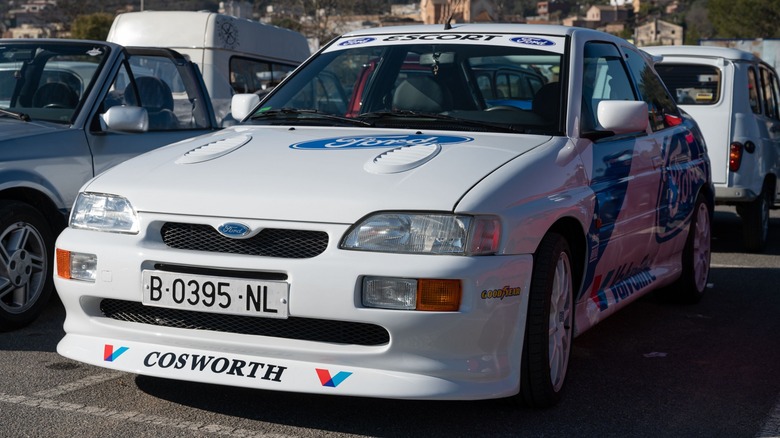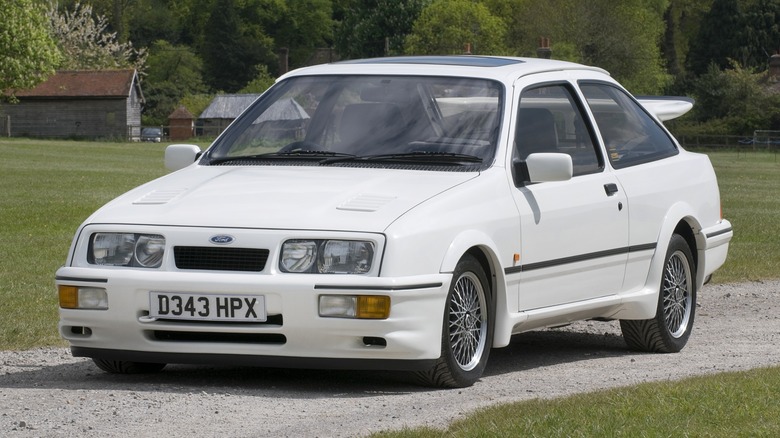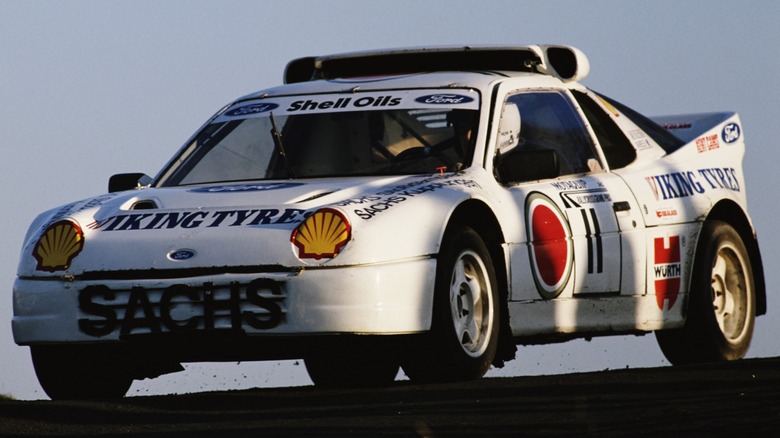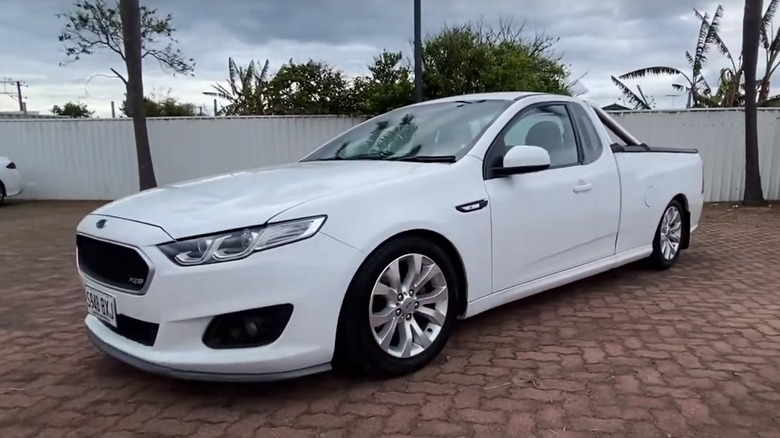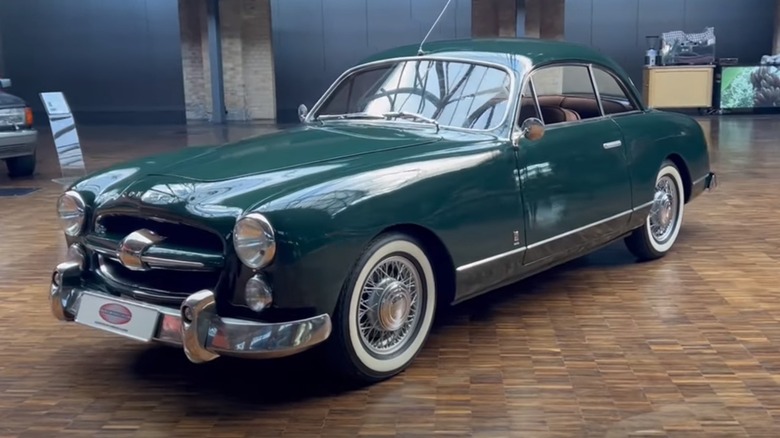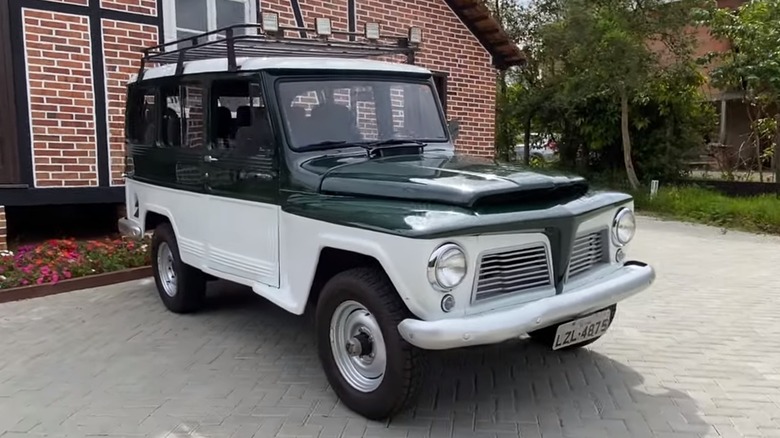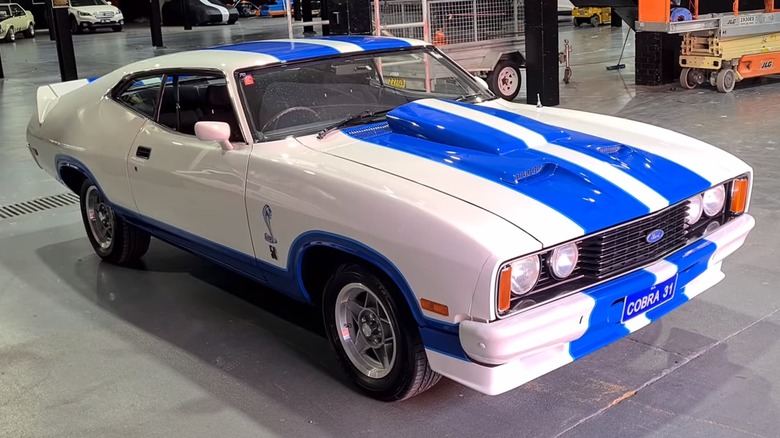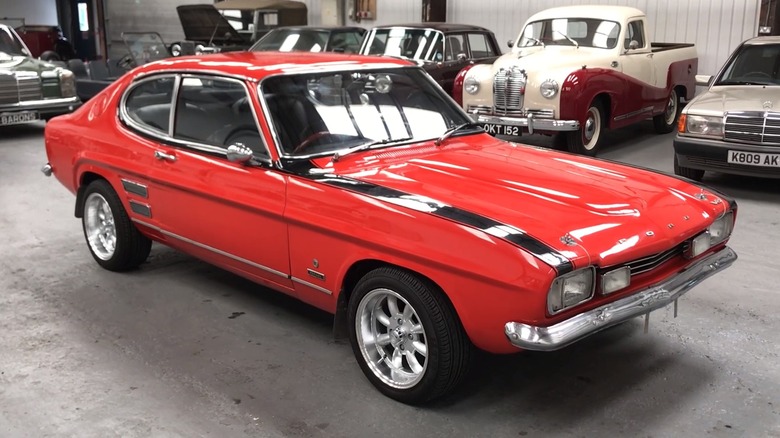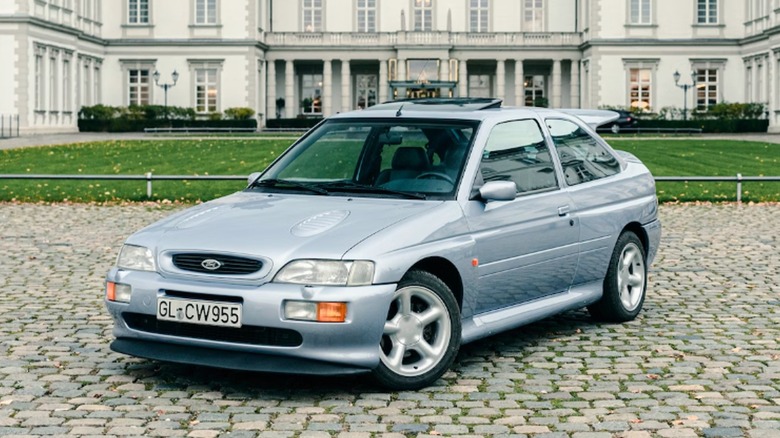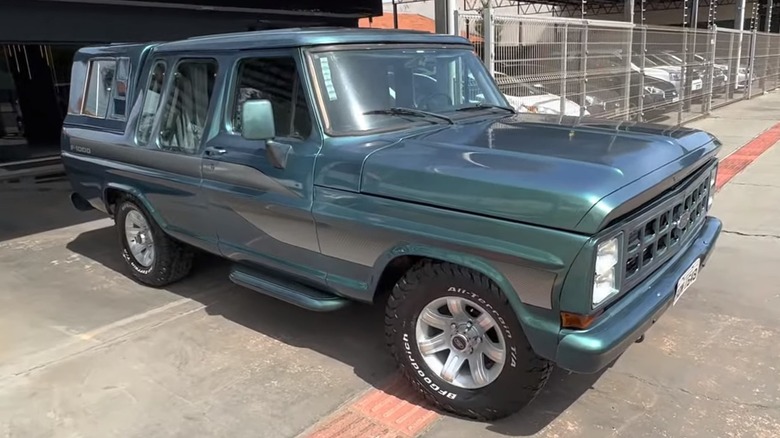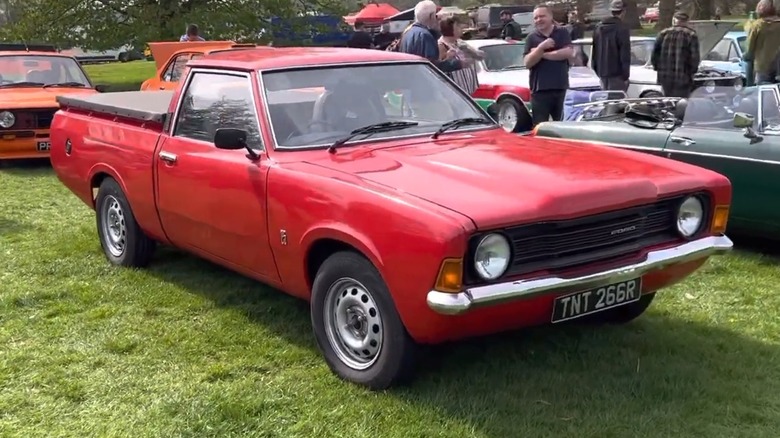10 Of The Coolest Foreign Fords You Couldn't Initially Get In America
Ford Motor Company is not just a giant of the auto industry in the United States, it is a giant worldwide. Its first foreign manufacturing facility was established in Ontario in 1904, primarily for selling cars in Canada while avoiding tariffs on products made outside of the British Empire. While Ford exported its vehicles almost immediately after establishing the company, its first foreign assembly plant was established in Trafford Park, England in 1911. Ford's international business has been an integral part of the company throughout its history, and today its products are produced in 65 facilities around the globe and employ 175,000 people.
The needs of British drivers differ greatly from those of American drivers, owing heavily to the streets following ancient routes in compact city spaces, so Ford designed a new car in the States to be built in Britain for Britons. Sold from 1932 to 1937, the Model Y, which replaced the Model A, became the first car built for an international market to wear the Ford emblem. A steady succession of foreign Ford models have come from Ford's operations in Europe and elsewhere, some of which Americans may have wanted to buy. Today, most Ford models are built on global platforms and homogenized among all of its markets with a few exceptions, but you can buy the older international models as long as they are at least 25 years old. Nonetheless, here are 10 of the coolest examples of those foreign Fords (initially) unavailable on American shores.
Ford Sierra RS Cosworth
While the name Cosworth has been affixed to a couple of American domestic market (ADM) cars like the Chevrolet Cosworth Vega, it's legendary on the British Isles. Cosworth is an engineering company that has been building engines for racing since 1958 and is often contracted to make high-performance versions of production cars by manufacturers. The European Ford Sierra, produced from 1982 to 1993, received some Cosworth love to become the legend.
The Sierra featured a forward-thinking design that shook up the market upon introduction and went on to be a good seller. It did show up in American dealers for a few years as the oddly named Merkur XR4Ti, although not with the Cosworth treatment. Developed initially as a homologation special to get Ford back into a competitive position in European racing, it found instant success with buyers. The Sierra received a body kit while Cosworth worked up a new cylinder head with dual cams and 16 valves for the 2.0-liter 4-cylinder engine. This made it good for 201 horsepower, although Cosworth stated that 400 was possible with race tuning.
5,545 examples were built before the Sierra was retired in 1992. Power was boosted to 220 in 1990 and a four-wheel-drive system was installed to provide better traction on rally circuits. It remains a great-looking hot hatch that was once one of the quickest cars in Britain. It was never sold Stateside but can now be imported, although they have become highly collectible and priced accordingly.
Ford RS200
The Ford GT40 was not the only mid-engine race car created and sold to the public by the company. In the 1980s, the FIA Group B class of rally racing was heating up and manufacturers were scrambling to get cars entered that could win — that's how we got the superb Porsche 959. The European racing division of Ford was just as eager to compete as the others and had plans to build an Escort for the circuit but scrapped those plans in favor of a more competitive clean-sheet design that would be introduced for the 1986 season.
Ford introduced a prototype of the Ford RS200 in 1984. Ghia styled its exterior while Ford created the rest from scratch, including a bespoke monocoque and tube-steel chassis with a fiberglass body and turbocharged 1.8-liter 4-cylinder sitting amidship and producing up to 444 horsepower on track-ready cars. Consumer models were limited to 246 horsepower. It also had an advanced suspension setup that, combined with its low weight, made for an extremely fast and agile car.
Sadly for Ford, Group B was canceled in 1986 before the RS200 could be fully certified. Ford built its 200 cars anyway and put them up for sale. They had been rushed and the finished quality was shockingly poor. Ford had to correct the quality issues and then sold them all to the public, although it drove the price beyond that of a contemporary Ferrari. Today they sell for hundreds of thousands of dollars.
Ford Falcon XR6 Ute
For many years, Australian customers of Ford had only to choose from models provided by Ford of Britain. Knowing that Australia is a very different place, Ford built a factory in 1959 to begin building Australian Fords for Australians to buy. One of the first models to come from this factory was the Falcon. Initially, it mirrored the American Falcon but continued in production after the American car was retired. It then stayed in production for decades, becoming one of Australia's favorite cars.
Falcon production only ended when Ford pulled the plug on Australia and closed down all manufacturing operations in the country. However, this did not happen before it cranked out a couple of bangers, the Ford Falcon XR6 Turbo Ute included. In this final car/truck built from 2014 to 2016, Ford stuck a 4.0-liter turbocharged straight-6 with 362 raging horses under the bonnet. The Barra engine debuted in 2002 and powered Falcons until the end while gaining a reputation for being tough and reliable while being capable of producing a huge amount of power.
Its styling is consistent with other Ford models of the era, similar to the contemporary Fusion or Taurus. However, the Falcon comes with open-air cargo space and great handling, something that is forbidden fruit in the States. Fast utes have long been the domain of Australian petrolheads. Furthermore, it will have to stay that way as these late-model Falcons won't be eligible to import for many years to come.
Ford Comète
You must be seriously geeked out over Ford's production history to know that its cars were once manufactured in France. Documentation online of the early history of Ford of France is spotty at best, but in the post-war era, Ford sold a few original models built in its factory in Poissy. Easily the most beautiful and elegant of these is the Comète.
The most popular Ford of the era and in that area was the Vedette, a typical European sedan of the early '50s. But using the chassis of that car, Ford had a body styled by Stabilimenti Farina — predecessor to the coachbuilder Pininfarina — and built by the Facel Vega predecessor, Facel-Métalon. French fords of the day used the smaller Ford Flathead V8-60, which displaced 2.2 liters and produced just 66 horsepower, although that would later increase to 80. It was built to high standards of luxury and looked the part from the outside but with a basic and spartan interior, although at least some were upholstered in leather.
Comète production ran from 1951 to 1955. This was during the post-war period in which France was in the process of rebuilding and little money for hand-built luxury cars existed. As a result, only 699 of these gorgeous cars were built. In the rare circumstances that these appear at auction, bids in the $50,000 range are expected to win.
Ford Rural
Ford factories were found everywhere, including in Brazil, throughout much of the 20th Century. Ford's history in the country is convoluted but interesting. Established in 1904, Ford sought to sell vehicles and later established an assembly plant followed by an attempt to source rubber for production directly from the source, leading to the establishment of an ill-fated company town called Fordlandia. Ford continued its presence in Brasil through WWII and the post-war period. In 1967, Ford took over the Brasilian operations of Willys, which had continued manufacturing vehicles for years after Kaiser acquired the brand in the States.
Ford's production of the Willys Wagon, which was originally designed in 1946, continued with relatively few changes, although it was renamed the Ford Rural. Brazilian Willys models featured a different grille, possibly to avoid using the trademarked Jeep 7-slot grille, and Ford-built models lacked Willys Rural badges and had Ford lettering on the tailgate. If you look at interior pictures of models from the '70s, it is clear how outdated they were even back then. No amenities or conveniences exist, but you can be sure these old wagons are tough.
Finding detailed information about these cars is tough, at least when searching in English. Straight-6 engines powered them, and Ford continued making them with Kaiser engines until 1975 when it switched to Ford 4-cylinder engines just before killing off the 30-year-old platform in 1977.
Ford XC Falcon Cobra
When Ford started building in Australia, it resulted in some uniquely cool cars that the locals could claim as their own. This included the Falcon, at least in part because of some of the special high-performance variants produced, such as the Ford Falcon Cobra XC.
While the Aussies were designing and building their own cars, they were also still making Fords, which meant they had the intellectual property and parts supplies from the parent company. That allowed them to build an Australia-specific model powered by the same 351 V8 found further north. When combined with a hardtop coupe version of the Falcon and custom paint, it made the car worthy of also bearing the Cobra logo.
When the Cobra XC was released, the hardtop coupe model was on its way out due to waning sales of that body style. Ford used this excuse to expend excess inventory and the special edition was meant to build excitement. The bodies are all painted Bold Blue and the Sno White paint is applied over it, even though it looks as if it would be the opposite. Options included four-wheel disc brakes, dual exhaust, and a limited-slip differential paired with a unique front air dam and rear spoiler to make an exciting car with genuine muscle car looks. In all, Ford built 400 copies which have since become highly collectible. They rarely come up for sale, but Shannons auctioned one in Sydney in 2016, and the winning bid hit $100,000.
Ford Perana Capri V8
Ford's European divisions in Britain and Germany put together a new vehicle for the 1967 model year that turned out to be one of the continent's favorite cars of the era, the Ford Capri, Europe's pony car. While it was a very popular car in Europe, it found favor elsewhere and was also manufactured in South Africa. As in Europe, engine options for the first generation Capri were a Kent 1.6-liter inline-4 or the Essex V4. While both choices were rational and economical choices for Europeans, South Africans cranked things up to 11.
In 1970, Ford South Africa began offering an Essex V6 as an option, but a man named Basil Green of Basil Green Motors couldn't be satisfied with that. He started dropping 5.0-liter V8 engines from the Mustang into Capris. Green's creation had been named the Perana Capri V8, and the alteration soon became an approved upgrade by Ford, with new cars built by the factory and sent with no engine or transmission to Green for upgrades.
The resulting car made 281 horsepower thanks to a Holley carburetor and high-rise intake manifold, and power ended up at a limited-slip differential. This rather small car came only with Bright Yellow or Piri Piri Red paint and made a splash everywhere it went, whether that was on the street or the track. About 550 Peranas were built in total to satisfy homologation rules for racing, and they are now highly valuable South African treasures.
Ford Escort RS Cosworth
The European Ford Escort first appeared in dealers as a 1968 model as Dord's mass-market small car. It found instant success, racking up record sales and hitting the 2 million unit mark by 1974. While it did well on the streets, it also appeared on many racing circuits, including at least a few driven by Cosworth-built engines. The success continued through multiple generations, and in 1991, the Mark V Escort debuted with fresh and modern styling. Accompanying the regular passenger cars was the Ford Escort RS Cosworth, unleashing the engineering and power of rally racing on public roads.
Borrowing from the popular Sierra Cosworth, Ford placed the same 2.0-liter 4-cylinder engine with a Cosworth-engineered head and a turbocharger with a two-stage intercooler under the bonnet. This meant placing the body of a smaller escort hatch onto the chassis of the Sierra — it did not just use the same engine. Coachbuilder Karmann was recruited to merge the two cars into one race-ready platform that could be produced in sufficient numbers to satisfy homologation requirements. Regardless of the Frakenstein process in producing the car, it turned out to be a brilliant machine with looks that have aged very gracefully.
Ford built the Cossie from 1992 to 1996 with a production total of 7,145, the first 2,500 units made to satisfy homologation. All of them have become quite valuable and remain exciting cars. The last one built in 1996 recently sold for €53,700 (about $57,822) by Collecting Cars.
Ford F-1000
The Brazilian automotive market has long operated independently and come up with many unique creations as Ford's foreign divisions are empowered to tailor products for the local market. With Brazil's immense territory of untamed wilderness, pickups are ideal for the market. Ford began 5th-generation F100 pickup production in the country in 1972, offering its version of the F250 as the F1000. Ford do Brasil manufactured F-1000 pickups until 1992, and, fascinatingly enough, did not change anything about the exterior except for the grille and bumpers, although interiors updated with the times. But what makes Brazil's F-1000 trucks so interesting is the many custom trucks built by coachbuilders. Initially, Souza Ramos, which had been creating customs for many years, received trucks directly from the Ford with certification to transform and sell them with a full factory warranty. Five other companies later joined SR in building F-1000 customs.
Long before the double cab became the standard truck in America, Brazilians enjoyed various iterations of the style. Some had four doors while others substituted large picture windows in the rear. Some unique trucks had a bed, of which there only remained a few feet, turned into a giant truck and the F-1000 effectively became an all-terrain sedan. The many options and configurations are genuinely wild, especially when, for example, they are applied to a 1990 truck that looks mostly like a 1970 F-150.
Ford Cortina Bakkie
While Australia is known for utes, the South African version is called a bakkie. However, while utes are trucks based on cars, bakkie generally describes any kind of small truck, some of which are also based on cars.
In the '60s, Ford South Africa developed plans for a new light pickup, creating prototypes built from the Taunus, Corsair, and Escort before landing on the Cortina as the ideal platform. Sales of the new truck began in 1971. Although Cortinas were popular cars in many other markets and top sellers in Europe, the bakkie was to be an original South African creation. Kent 1.6-liter 4-cylinder engines powered the first examples out of the factory but were soon joined by a 2.5-liter V6 option. An updated model arrived in 1977 with an optional Essex 3-liter V6.
The Cortina bakkie is significant for South Africa as it was the first Ford built in the country to be exported. The second-gen model, which had been officially known as the Ford Pickup, was renamed the Ford 1-Tonner as Ford wanted to reinforce its heavy hauling ability and distance its association with a passenger car. No matter what they called it, the bakkie was a huge success in Africa and Europe, and it continued in production for another three years after the Cortina was replaced by the all-new Sierra. No matter what it's called, the bakkie was a cool little truck Americans were never offered, but it should have been.
